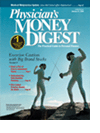Publication
Article
Physician's Money Digest
The Return of the Bull
In 2003, residents of New York City's Chinatown ushered in the year of the ram. A few blocks farther south, Wall Street was celebrating the year of the bull, as stock prices soared to levels not seen in a while. The return of the bull market shattered a rare 3-year losing streak for stocks and lifted market averages to levels not seen by investors since early 2002.
Even Santa Claus brought a sack of goodies to the Street in 2003. The S&P 500 rose 4.8% in December, topping off a sizzling 11.6% fourth quarter gain. Overall, the S&P 500 was up 26.9% for the year, with the Dow posting a 25.3% annual gain. In fact, only four of the Dow's 30 stocks posted losses for the year. The Nasdaq rocketed to a 50% gain in 2003, closing above the 2000 level at the year's end.
Welcome Change
The winning year was a welcome change from 3 straight years of market misery. The yearly gain in the Dow matched the gain posted back in 1999, the last year that any of the major averages showed a profit. For those physicians who have been in the stock market since the tech bubble burst in March 2000, however, last year's winning performance didn't come close to getting them back to the break-even point. The Dow is only halfway back to the high it hit in 1999 and the Nasdaq is still a couple light years away from its all-time high of 5048.62, set in March 2000.
In early 2003, the market moved downward as investors pondered the possibility of war in Iraq. In typical sell-on-rumor, buy-on-news fashion, however, the bull market began in earnest almost to the day that coalition troops began their assault on President Saddam Hussein's regime. After hitting the year's low point in early March, the S&P 500 racked up a 38% gain to finish the year at 1111.92. The tech-heavy Nasdaq did even better, streaking to a 58% gain from its March low.
Overseas Faring
Investors who took the risk of investing in overseas markets also reaped a robust profit last year, with the Dow Jones world stock market index climbing 38.5%. The biggest winners were those who looked south to Latin America. The Dow Jones Latin America Index took off, ending the year with a gain of more than 75%. European and Asian stocks also did well, with both up about 37%.
Bonds defied the experts, who had predicted a drop in bond prices as the economy heated up. Although prices did take a sharp drop in June, the 10- year US Treasury note still managed a 1.3% gain in 2003. Junk bonds, which often act more like stocks, leaped 28.1% and emerging market bonds took off to a 27.5% gain. Real estate and precious metals also continued their winning ways. The Dow Jones Real Estate Sector Index was up 28.3% for the year, while the precious metals sector posted an impressive 55.6% rise.
Does this bull market have legs? History, in the form of a US presidential election year, is on the market's side. Since 1897, the market has averaged an annual 9.2% return in presidential election years. In years when a Republican occupied the White House, however, the average gain has been 13.7%. Dollar blues: The one disturbing cloud on the horizon is the falling dollar, which has recently hit all-time lows against the euro and multiyear lows against the yen and the British pound.
